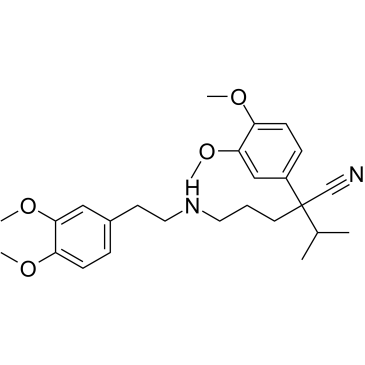| Description |
Norverapamil ((±)-Norverapamil), an N-demethylated metabolite of Verapamil, is a L-type calcium channel blocker and a P-glycoprotein (P-gp) function inhibitor[1][2].
|
| Related Catalog |
|
| Target |
Calcium channel blocker[1] P-glycoprotein (P-gp) inhibitor[2]
|
| In Vitro |
Norverapamil ((±)-Norverapamil) is similarly effective as verapamil at inhibiting isoniazid and rifampicin tolerance and killing of intracellular M. tuberculosis in the absence of other drugs. norverapamil, also inhibits macrophage-induced tolerance and achieves similar serum levels to verapamil[1]. Verapamil and its major metabolite Norverapamil were identified to be both mechanism-based inhibitors and substrates of CYP3A and reported to have non-linear pharmacokinetics in clinic[3].
|
| In Vivo |
Norverapamil (9 mg/kg; p.o.), a major metabolite of verapamil, has terminal half-life, AUC and Cmax values of 9.4 hours, 260 ng▪h/ml, and 41.6 ng/mL, respectively[4]. Animal Model: Male Sprague-Dawley rats[4] Dosage: 9 mg/kg (Pharmacokinetic Study) Administration: Oral administration Result: t1/2=9.4 hours;AUC=260 ng▪h/mL;Cmax=41.6 ng/mL.
|
| References |
[1]. Adams KN, et al. Verapamil, and its metabolite norverapamil, inhibit macrophage-induced, bacterial efflux pump-mediated tolerance to multiple anti-tubercular drugs. J Infect Dis. 2014 Aug 1;210(3):456-66. [2]. Pauli-Magnus C, et al. Characterization of the major metabolites of verapamil as substrates and inhibitors of P-glycoprotein. J Pharmacol Exp Ther. 2000 May;293(2):376-82. [3]. Wang J et al. A semi-physiologically-based pharmacokinetic model characterizing mechanism-based auto-inhibition to predict stereoselective pharmacokinetics of verapamil and its metabolite norverapamil in human. Eur J Pharm Sci. 2013 Nov 20;50(3-4):290-302. [4]. Choi DH, et al. Effects of simvastatin on the pharmacokinetics of verapamil and its main metabolite, norverapamil, in rats. Eur J Drug Metab Pharmacokinet. 2009 Jul-Sep;34(3-4):163-8.
|

 CAS#:38321-02-7
CAS#:38321-02-7